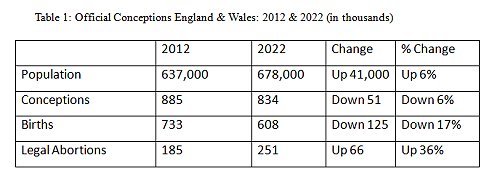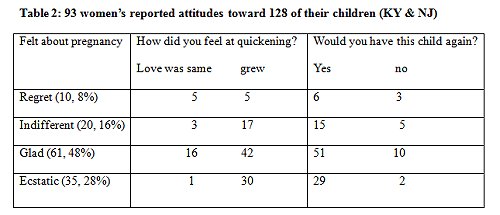
Paul Cameron
In the early 1900s, President Teddy Roosevelt asked women to have fewer than their average of 6 children – using the money saved to better educate them. That was then.
Of late, some in academia and the commentariat are preaching demographic doom. In 1991, Pat Buchanan ran for president warning of a baby-dearth; in 2013, the popular book What to expect when no one is expecting warned of a coming population collapse; and Trump’s Big Beautiful Bill rewards having babies. Elder care is in crisis, with millions of the aging being underserved. In July, the U.S. Chamber of Commerce reported that for every 100 job openings, only 92 workers were available. Is the U.S. short about 1 million workers? Has the recent call for babies affected birth or abortion numbers?
Table 1 summarizes the official tally of births in England and Wales (mirroring those in the U.S. but including verified conceptions). The UK reported that the proportion of conceptions leading to legal abortion in 2022 reached its highest recorded level.

In 2012, approximately two of every ten UK official conceptions ended in legal abortion. In 2022, legal abortions affected about three of ten. Even though the UK population (as with the U.S. population) increased 6%, the proportion of known conceptions and births decreased 6% and 17% respectively. Table 1 includes conceptions for which women sought medical confirmation, but not those resulting in miscarriages or illegal abortions. The U.S. and the UK recorded 1.6 children per woman in 2023, well shy of the 2.1 per woman to sustain the population.
For a modern society to survive, women must want to bear children. But childlessness hogs the limelight. The media centers on deviance (everyday life is boring), so our lives are filled with commercials and content that disproportionately highlights child-free lifestyles. This gives us ample exposure to people and activities which, in the past, only a few of us would be aware.
Before SCOTUS legalized abortion in 1973, I assessed a random sample of 225 mothers’ claims about their 309 children. I conducted the survey in New Jersey and Kentucky shopping centers. Participants filled out a questionnaire about one or (for 10) two of their randomly selected children [https://eric.ed.gov › ?id=ED081485]. Because some of the data was destroyed, only 93 women’s detailed responses regarding 128 of their children are summarized in Table 2.

The 225 mothers reported love for 94% of their 309 [mostly adult] children selected, but less than love for 19 (6%) [two were hated, 4 were disliked, 6 were regarded with indifference, and 7 liked to some degree]. These answers, from mothers aged 19 to 64 – 4 of whom reported having had an abortion and 4 who wanted an abortion for this birth – are from mothers who lived through the high point of pro-natal Christian influence in the U.S. (the 1950s) and a moderated media. Table 2 suggests that – even 50 years ago – motherhood was not all sweetness and light: 8% of mothers said they regretted the pregnancy, while 35 were ecstatic. Further, testifying that motherhood is associated with uncertainties, the mothers in Table 2 claimed that if they had the choice, they would not go through the pregnancy again for a sixth of their children. As various polls from 2013-2021 indicated 7% of U.S.-, 8% of German-, and 8% of UK-parents said they wished they hadn’t had children, the findings in Table 2 may be close to "the truth."
How is motherhood different today?
The list is long, and no one is sure which constitute the "relevant" items. The U.S. is richer and mothers are working outside the home more. In 1970, the average new house had 1,400 square feet for 3 or 4 occupants; today it is about 2,300 for 2 or 3. Then, in half of two-parent households the father worked and the mother stayed home. Today, half as many two-parent households are the same. Back then, a third of homes had two parents working full time, now it is almost half. Single parents make up a quarter of today’s homes vs only 6% in 1970.
Today’s potential mothers are informed of four procedures/drugs that impact pregnancy: contraceptives, morning-after pills, abortifacients, and IVF. The first three prevent or terminate pregnancies, often free or low cost, while IVF [which accounts for about 2% of births] costs considerably out of pocket. As such, it would not be difficult for most women to believe society values blocking or eliminating pregnancies more than it values births.
Abortion is more popular and has acquired a "human right" status. In FRI’s 1983-4 national random survey, one in five women said they had obtained an abortion. In 2024, Guttmacher reported an increase to one in four. Abortion has recently acquired a "women’s rights" status. In 2022, the U.S. Supreme Court said abortion is not a Constitutional right. In 2024, the electorate in ten states voted on it – about two-thirds of U.S. voters held that a pregnant woman had a right to abort.
The pro-abortion decision by millions of American voters impacted the world
While U.S. states have enacted laws both for and against abortion, the 2024 votes indicated how most Americans lean, and what Americans believe is IMPORTANT. As the richest, freest, and most powerful 4% of the world’s population, the U.S. not only sets the standard of "what’s desirable" for the other 96% [who generally want to imitate Americans], but overwhelming U.S. votes are often regarded as setting the standard about what is right for the other 96% (including their judiciaries and bureaucracies). The 2024 elections meant that abortion went from a disputed to a "majority supported" right – closer to an ordinary medical procedure than the killing of a growing human. After the 2024 elections, some states decided to subsidize abortions (and sometimes travel) for women from states that did not allow them. abortions. Many educational institutions and women’s rights groups said they would sponsor abortions while no state is advertising to pay for births, per se. The childless life – which imperils our survival – is supported rather than criticized (every citizen has the same "one vote"). The Federal government has also subsidized abortions abroad, depending on the administration.
Inventions of the birth control pill, day-after-pill, and abortifacients – and feminist/civil rights/egalitarian laws – work against society having enough babies unless women resolutely decide to have more. Abortifacient pills already account for ~60% of legal abortions, and the other two pills likely account for some reduction of babies in Table 1. As "how to use these abortifacients" is all over the internet, and they are often donated/available from abortion activists – these drugs are likely used by tens of thousands of women. Plus, women's increased participation in the workplace often delays their family and presents additional challenges. Given the weight of opinion (and votes) against giving birth, no wonder an increasing proportion of U.S. women question whether they will ever have children.
We have entered a time when U.S. women can contracept, get pregnant (from sperm banks), take a morning after pill, get a pregnancy test, or induce a chemical abortion at low or no cost – without anyone else knowing. The same is not true of using IVF to have a baby, in which many are involved.
This possibility of total independence of women from men regarding births is new – all the decisions about pregnancy and its outcome can belong to the "fairer sex." We have become so atomized that if she has the requisite pills, she and she alone can decide whether a child will emerge from her pregnancy. And she can ignore what the biological father or society might think.
The U.S. believes in equality of the sexes, not their interchangeability. That is, each sex has its strengths and weaknesses. This makes each sex, in general, better at some things and worse at others.
Nationwide surveys regularly report that– starting in the teens – a larger proportion of females than males test more mentally disturbed/distressed/depressed/suicidal/unhappy. In line, women make up about two-thirds of talk therapy clients. Proportionately more men are involved in our economic and military engines, but also more apt to engage in substance abuse, sexual misconduct, or criminality.
Should society allow the sex contributing less to its defense and economic success [elaborated next column] be given the possibility of total control over the number of births? (to be continued)
© Paul CameronThe views expressed by RenewAmerica columnists are their own and do not necessarily reflect the position of RenewAmerica or its affiliates.



















